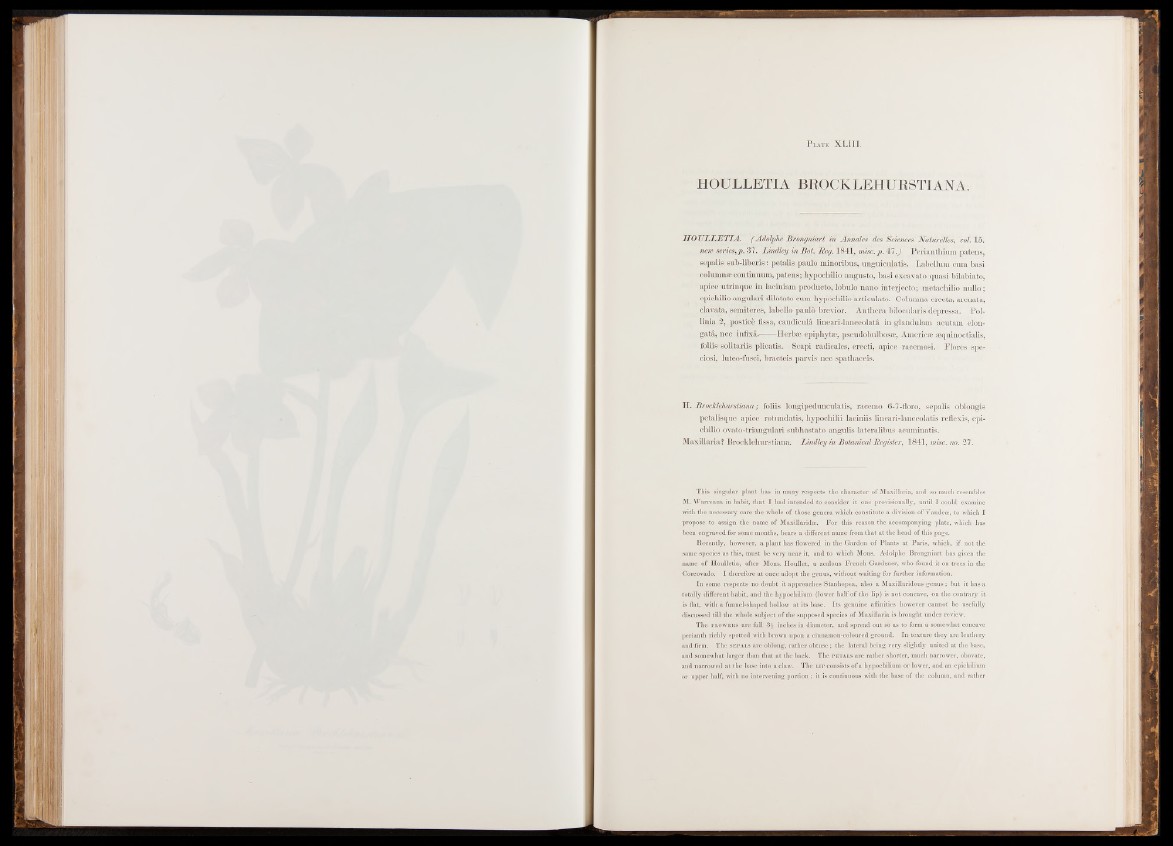
P late XLIII.
HOULLETIA BROCKLEHURSTIANA.
H O U L L E T IA . (Adolphe Brongniart in Annales des Sciences Naturelles, vol. 15.
new series, p . 37. Lindley in Bot. Beg. 1841, mise. p. 47.) Perianthium patens,
sepalis sub-liberis : petalis paulo minoribus, unguiculatis. Labellum cum basi
columnæ continuum, patens; hypochilio angusto, basi excavate quasi bilabiate -,
apice utrinque in laciniam producto, lobulo nano inteijecto; metachilio nulle ;
epichilio angulari dilatato cum hypochilio articulato. Columna erecta, arcuata,
clavata, semiteres, labello paulo brevior. Anthera bilocularis depressa. Pol-
linia 2, posticè jfissa, caudiculâ lineari-lanceolatâ in glandulam acutam elongatâ,
nec infixâ,—----ïïerbæ epiphytæ, pseudobulbosæ, Americæ æquinoctialis,
foliis solitariis plicatis. Scapi radicales, erecti, apice racemosi. Flores spe-
ciosi, luteo-fusci, bracteis parvis nec spathaceis.
H. Broclclehurstiana ; foliis longipedunculatis, racemo 6-7-floro, sepalis oblongis
petalisque apice rotundatis, hypochilii laciniis lineari-lanceolatis reflexis, epichilio
ovato-triangulari subhastato angulis lateralibus acuminatis.
Maxillaria1? Brocklehurstiana. Lindley in Botanical Register, 1841, mise. no. 27.
This singular plant has in many respects the character of Maxillaria, and so much resembles
M. Warreana in habit, that I had intended to consider it one provisionally, until I could examine
with the necessary care the whole of those genera which constitute a division of Vandeae, to which I
propose to assign the name of Maxillaridse. For this reason the accompanying plate, which has
been engraved for some months, bears a different name from that at the head of this page.
Recently, however, a plant has flowered in the Garden of Plants at Paris, which, if not the
same species as this, must be very near it, and to which Mons. Adolphe Brongniart has given the
name of Houlletia, after Mons. Houllet, a zealous French Gardener, who found it on trees in the
Corcovado. I therefore at once adopt the genus, without waiting for further information.
In some respects no doubt it approaches Stanhopea, also a Maxillaridous genus; but it has a
totally different habit, and the hypochilium (lower half of the lip) is not concave, on the contrary it
is flat, with a funnel-shaped hollow at its base. Its genuine affinities however cannot be usefully
discussed till the whole subject of the supposed species of Maxillaria is brought under review.
The flowers are full §|| inches in diameter, and spread out so as to form a somewhat concave
perianth richly spotted with brown upon a cinnamon-coloured ground. In texture they are leathery
and firm. The sepals are oblong, rather obtuse; the lateral being very slightly united at the base,
and somewhat larger than that at the back. The petals are rather shorter, much narrower, obovate,
and narrowed at the base into a claw. The lip consists of a hypochilium or lower, and an epichilium
or upper half, with no intervening portion ; it is continuous with the base of the column, and rather